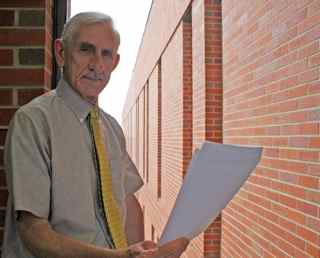T-00027: Immobilization of Cellulases and Hemicellulases on Porous Siran Glass Beads

Inventor: Basil Dalaly
Article and Photo by Lance Nixon
A South Dakota State University scientist is exploring ways to re-use enzymes in processes such as making cellulosic ethanol.
The research could lead to big financial savings for industry.
“Enzymes are usually very expensive items in chemistry or biochemistry,” said professor Basil Dalaly in South Dakota State University’s Department of Nutrition, Food Science and Hospitality. “One of the big obstacles in using enzymes in converting cellulose, or biomass, to ethanol is the high cost of enzymes. We are trying immobilize the enzyme by attaching it to beads. Afterwards, the enzyme could be used for more than one time — two, three, four, five times because the beads will keep the attached enzyme rather than allowing it to float away along with the processed products.”
Working with enzyme company Novozymes, Dalaly and his graduate student, Pavani Mandali, have evaluated several chemical methods to attach enzymes to beads. They then evaluated the enzyme activity, how well the enzymes attached to the beads, and other technical variables.
“From our results so far I can say we are successful in using the enzymes for five cycles, but with decreasing activity from 100 percent to 40 percent. We still retain 40 percent of the original activity of the enzyme,” Dalaly said.
He added that would be a huge financial advantage in industrial processes that rely on enzymes.
“Using the same enzyme for five times means you need not use a fresh batch of enzymes every time — you can use them over and over,” Dalaly said.
Mandali, who is working toward her Ph.D. in biological sciences, said the SDSU research shows enzymes attached to the beads have 95 percent of their original activity when used a second time; 75 percent of their original activity when used for a third cycle; 50 percent of their activity when used a fourth time; and about 35 to 40 percent of their original activity when used for a fifth processing cycle.
The SDSU study is part of a many-pronged project to develop more efficient methods to produce ethanol from cellulosic biomass, thought to be the source of the next generation of ethanol. Dalaly’s work uses biomass pretreated by engineers in SDSU’s Department of Agricultural and Biosystems Engineering.
“We are trying now to use biomass, corn stover and DDGS, to convert to ethanol,” Dalaly said.
His work so far shows the re-used enzymes work better on some biomass materials than others.
“In the near future we will use these immobilized enzymes in a small bioreactor on different kinds of biomass, not only corn stover and DDGS, but also big bluestem, switchgrass, and prairie cordgrass,” Dalaly said.
Dalaly’s work also looks at questions such as the time for all of the biomass to be hydrolyzed, or broken down. The project also involves analyzing the hydrolyzed biomass to determine what monosaccharides, or simple sugars, are in the hydrolysate.
Dalaly said as the SDSU work continues he and his student will address the problem of how to gather or recover the beads once a processing cycle is over.
In addition to the enzymes provided by Novozymes, the federal Department of Energy and the South Dakota Corn Utilization Council help support Dalaly’s research though grants. The North Central Sun Grant Center at SDSU also funded some of Dalaly’s early work looking at enzymes in pretreatment of biomass feedstocks.